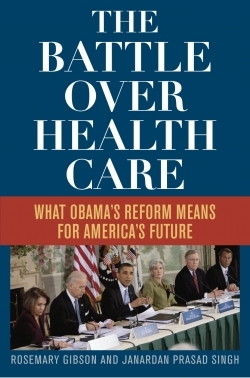The Battle over Health Care
What Obama's Reform Means for America's Future
Any well-informed person who is absolutely convinced that neither they nor any member of their family, nor anyone close to them, will ever have need of a doctor, hospital, or prescription drugs during the next hundred years can ignore this book. The same goes for anyone who has no interest whatsoever in how or whether the American system of self-government works. Otherwise, The Battle over Health Care: What Obama’s Reform Means for America’s Future should top everyone’s reading list. It is a thoroughly researched and well-written discussion of one of the most serious issues currently facing this country.
Rosemary Gibson is a recognized leader in health care reform. She is the author of several books on the subject, including the noted Wall of Silence, also co-authored by Janardan Prasad Singh, an economist at the World Bank who has been a member of an advisory council to several prime ministers of India.
The authors say, “We wrote this book for the American people. They are the only special interest we represent.” Gibson and Singh go on to demonstrate that their audience is the only group that was not part of the debate over health-care reform resulting in the passage of the Patient Protection and Affordable Care Act, also known derisively as “Obamacare.”
The Battle over Health Care is divided into five parts. Initially, the authors describe the process by which the dominant players in the health-care industry wrangled favorable concessions from congress and the White House. The next part explains how the current health-care system is deficient in providing quality, affordable health care to Americans and how it will be overwhelmed by the demands of the newly insured. Section three compares the health-care system to Wall Street, wherein Gibson and Singh indict the pharmaceutical companies, hospitals, doctors, and health insurance companies for being more interested in profits than in delivering better health care to patients. “For all the money spent on health care in the United States, life expectancy is no better than that of Cuba.”
Gibson and Singh take on conventional wisdom in part four, dealing with the relationship of the national debt to health-care costs. They assert: “Progress to reduce the ominous burden of the federal debt can be made only if health-care spending is reduced.” In the final part the case is made for real reform in the health-care system. Gibson and Singh propose ten steps toward that end, including authorizing the federal government to negotiate drug prices and more regulation of the health-care industry patterned after that used for aviation and highway safety. “The solution,” they believe, “is to reduce the health care industry’s dependency on the blind generosity of the public.”
The battle over health-care reform will rage on. It likely will be a major issue in the 2012 elections. Every citizen should be informed on these complicated, crucial issues. Gibson and Singh’s contribution is a wonderful place to start that education.
Reviewed by
John Michael Senger
Disclosure: This article is not an endorsement, but a review. The publisher of this book provided free copies of the book to have their book reviewed by a professional reviewer. No fee was paid by the publisher for this review. Foreword Reviews only recommends books that we love. Foreword Magazine, Inc. is disclosing this in accordance with the Federal Trade Commission’s 16 CFR, Part 255.

